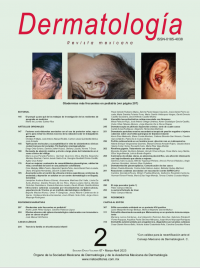Medical care demand and long-term impact of treatment on the clinical course of vitiligo.
Dermatol Rev Mex. 2023; 67 (2): 168-175. https://doi.org/10.24245/drm/bmu.v67i2.8743
María Luisa Peralta-Pedrero,1,2 Germán Guerrero-Oliva,1 Martha Alejandra Morales-Sánchez,1 Fermín Jurado Santa-Cruz,1 Georgina Quetzalli Chirino-Castillo,1 Agles Cruz-Avelar2
1 Centro Dermatológico Dr. Ladislao de la Pascua, Ciudad de México.
2 Unidad de Posgrado, Facultad de Medicina, Universidad Nacional Autónoma de México.
Resumen
OBJETIVO: Comparar si existe diferencia a largo plazo en gravedad, extensión y rapidez de la progresión en pacientes con vitíligo no segmentario que han recibido tratamiento vs los que no lo han recibido.
MATERIALES Y MÉTODOS: Estudio transversal prospectivo efectuado de enero de 2017 a diciembre de 2019 en el Centro Dermatológico Pascua, Ciudad de México. Se incluyeron pacientes de 18 años y más con vitíligo no segmentario. La extensión se midió con el Vitiligo Extension Score, la gravedad con el Vitiligo Area Scoring Index y la velocidad de progresión con la tasa de progresión anual.
RESULTADOS: Participaron 492 pacientes, con edad media de 46 ± 15 años, el 63% eran mujeres, edad de inicio de 36 ± 17 años (intervalo: 1 a 80). El 67% de los pacientes tenían menos de 10 años de evolución. Casi un tercio informó no haber recibido tratamiento. Los tratamientos recibidos fueron tópicos y en orden decreciente: psoralenos, inhibidores de calcineurina y esteroides. El tiempo de tratamiento fue de un mes a 25 años. Al comparar a los pacientes con tratamiento durante 7 meses o más versus los pacientes que no recibieron tratamiento o lo recibieron por un máximo de 6 meses, los primeros aumentaron la superficie corporal afectada en un 2.8%, mientras que los que no recibieron tratamiento la aumentaron un 12.7%.
CONCLUSIONES: Los pacientes que no habían recibido tratamiento tuvieron cuatro veces más superficie corporal afectada. A pesar del empeoramiento de la enfermedad, la demanda de atención médica se redujo con el mayor tiempo de evolución.
PALABRAS CLAVE: Vitíligo; tratamiento.
Abstract
OBJECTIVE: To compare whether there is a long-term difference in severity, extent and speed of progression in patients with non-segmental vitiligo who have received treatment vs those who have not.
MATERIALS AND METHODS: A prospective cross-sectional study was conducted at Centro Dermatológico Pascua, Mexico City, from January 2017 to December 2019. Patients 18 years and older with non-segmental vitiligo were included. Extension was measured with the Vitiligo Extension Score, severity with the Vitiligo Area Scoring Index, and rate of progression with the annual rate of progression.
RESULTS: A total of 492 patients participated, age 46 ± 15 years, 63% women, age of onset 36 ± 17 years (range 1 to 80); 67% of patients had lesser than 10 years of evolution. Nearly a third reported receiving no treatment. The treatments received were topical and in decreasing order: psoralens, calcineurin inhibitors and steroids. The treatment time was from one month to 25 years. Comparing patients with treatment for 7 months or more versus patients who received no treatment or received it for a maximum of 6 months, the former increased the affected body surface area by 2.86%, while those who did not receive treatment increased by 12.7%.
CONCLUSIONS: Patients who had not received treatment had four times more affected body surface. Despite worsening of the disease, medical care demand was reduced with longer time of evolution.
KEYWORDS: Vitiligo; Therapeutics.
Recibido: julio 2022
Aceptado: octubre 2022
Este artículo debe citarse como: Peralta-Pedrero ML, Guerrero-Oliva G, Morales-Sánchez MA, Jurado Santa-Cruz F, Chirino-Castillo GQ, Cruz-Avelar A. Demanda de atención médica y efecto a largo plazo del tratamiento en el curso clínico del vitíligo. Dermatol Rev Mex 2023; 67 (2): 168-175.

